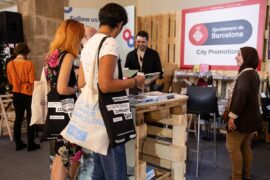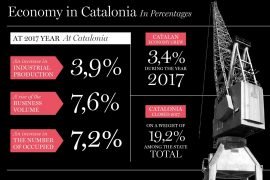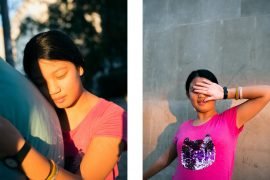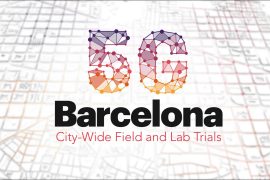[dropcap letter=”S”]
ometimes nothing is as it seems—or it seems more than it is. I meant to start this report with the letter ‘a’—if you keep reading you will understand why. In the universe of Jordi Larroch (Barcelona, 1978), the elements he tunes, and then photographs, take unexpected dimensions. His goal is to entreat the mind to play. With imagination. With meanings that are perhaps not so obvious. With double… no, no, wait… with many meanings propitiated by images that take you from surprise to reflection.
“It’s hard for me to feel I am a poet, not even a photographer or an artist. These are words for which I have great respect. And poets are also usually older, and I feel more at ease with stories, so if you like I am… a teller of tales!”
It’s time for (RECREO)—It’s playtime. Just so, in brackets and capital letters. That is how the artist dubs his new exhibition. “It’s a play on words: recreation refers to the school playground, hence the parentheses. It is a parenthesis between classes, when in theory you stop learning—and boy do you learn about other things. It’s time for recreation, it’s time for fun. Recreation also comes from creating; to recreate, to recreate yourself, to reinvent yourself. And from this idea comes everything else. I want people to free their minds with these photographs,” Jordi explains. In his new collection he includes a total of 25 pictures, although under this same premise he created 40. And you will find them exhibited at the Centre Cívic Golferichs in Barcelona—admission is free.
 The most common term for this kind of photography is “visual poetry”. But Jordi Larroch is so modest that he opts for others, like “plastic metaphors”. “It’s hard for me to feel I am a poet, not even a photographer or an artist. These are words for which I have great respect. And poets are also usually older, and I feel more at ease with stories, so if you like I am… a teller of tales ! Believe it or not, stories also gets my respect, eh? Who hasn’t picked up a broom as a child and pretended it’s a mic stand? The object itself has this ability to evoke dreams. Or maybe what I do is make fables, which are still shorter than stories. But wait, then I can derive that word and I become fabulous. No, no, less still,” he laughs in the middle of the gallery, surrounded by his photographs—fabulous, whatever he says.
The most common term for this kind of photography is “visual poetry”. But Jordi Larroch is so modest that he opts for others, like “plastic metaphors”. “It’s hard for me to feel I am a poet, not even a photographer or an artist. These are words for which I have great respect. And poets are also usually older, and I feel more at ease with stories, so if you like I am… a teller of tales ! Believe it or not, stories also gets my respect, eh? Who hasn’t picked up a broom as a child and pretended it’s a mic stand? The object itself has this ability to evoke dreams. Or maybe what I do is make fables, which are still shorter than stories. But wait, then I can derive that word and I become fabulous. No, no, less still,” he laughs in the middle of the gallery, surrounded by his photographs—fabulous, whatever he says.
The fact that Jordi Larroch is a conceptual photographer and masters the use of emotions so well is the fruit of many years dedicated to art, albeit in different disciplines. “I studied music at the Taller de Músics in Barcelona. I wanted to be a drummer. I moved to Pamplona in northern Spain for love, but could not find work, so I began to communicate through photography”
Another constant Jordi faces is that of tiresome comparisons with Chema Madoz. “There is very little photographic culture and they always end up naming the same names, but there used to be others, like Daniel Gil who did the covers of publishing house Alianza Editorial,” he explains. What is sure is that the iconic references are inevitable—much to his regret. “And then there are the purists who get upset when we title the photographs, that we use the word when the image speaks for itself,” he adds. “Actually, it seems to me to be an absurd, retrograde debate. The title is not at the centre of the work. It is one more option. One more tool to play with.”
He is absolutely right. In fact, I recommend stopping to look at the ingenious, revealing titles of his prints. Let me give you an example: The hidden idea is how he baptizes a nutcracker placed inside out. At least, that is what you see at first glance. But a bulb lights—literally—when you see the shape below, inside the utensil: it is one of those screw-in ones. To sum up, the title gives you an idea about how to see the light.
The fact that Jordi Larroch is a conceptual photographer and masters the use of emotions so well is the fruit of many years dedicated to art, albeit in different disciplines. “I studied music at the Taller de Músics in Barcelona. I wanted to be a drummer. I moved to Pamplona in northern Spain for love, but could not find work, so I began to communicate through photography. I created an Instagram account called Para4gatos, where I posted the pictures I took in the streets, with more or less funny titles. It went well and there were people who asked me if I was a scriptwriter. The fact is that later I got several jobs that stopped me from going out so much and I started taking pictures at home. Some were really silly nonsense, but with his touch of humour. One day Chema Madoz gave me the book Obras maestras—Masterpieces, and I remembered that when I was 17 years old I went to the Chema Madoz y Joan Brossa (Fotopoemario) exhibition and I thought I knew what they were saying. That I could also use that language. Also, I’ve always been obsessed with the letter ‘A’. The names of my two children begin with ‘A’. And I have two ‘As’ tattooed on my arm,” he says as he shows them to me. And Brossa—considered one of the patriarchs of object poetry—played around a lot with that very same letter. Following the example of the book by Madoz, I locked myself in a room and began taking pictures without stopping, turning them out wholesale. In a year I got to do 500. I was posting them on social networks and I saw that people liked them. Word of mouth began to do its work and I was able dedicate my work to that.”
He has not abandoned music, in one way or another, since it slips into several of his photographs. In (RECREO), he titles a picture of broken spectacles Imagine, which you immediately relate to John Lennon. A baby’s dummy set with a mini metal basin, such as the one Don Quixote wore as a helmet, is called Esos locos bajitos—Those Little Loonies, a wink at a song by folk singer JM Serrat. And a Madrid indie rock band Vetusta Morla vinyl—out of curiosity, I wheedle out who the record is by—serves as a black hat for Harmonía.
Childhood, his and that of his children, is very present in (RECREO). “Each photo has a personal experience behind it and speaks of the passage of time, how it escapes us, that we should not lose the opportunity to enjoy it.”
His high-flying imagination does not go unnoticed. And he has had the artistic vein from the very beginning. “At age 4, they already signed me up for drawing classes because the teacher said I was good at it. At home, when they punished me and sent me to my room, it was wonderful for me. It was just what I wanted: to lock myself in and draw. Then I decided to write. I won the school contests but I refused to collect the prizes. On one occasion I asked them to give me the second prize so I would not have to swallow that bitter pill.”
Childhood, his and that of his children, is very present in (RECREO). “Every photo has a personal experience behind it and speaks of the passage of time, how it escapes us, that we should not lose the opportunity to enjoy it.” Another detail to keep in mind is that “in none of the images is there a photographic montage, everything is real! All those objects exist… still. Well, except this apple that has rotted, of course”[the apple in question has a hook instead of the usual stem and is entitled El pecado—The Sin]. Let’s be clear: Jordi Larroch does not use Photoshop. “What’s more, I’ve gone over to analogue to be even more precise. I have to shoot 12 photos and make the most of them, look for the perfect light.”
Life is too short just to see photos of influencers on Instagram, don’t you think? “It’s very clear to me: yawning is the biggest influencer there is: if I yawn, you yawn and in so doing, you will lack oxygen in the brain. As a concept, it bores me.” For Larroch, Instagram [jordi.larroch] is a platform that lets him share his work. “I use it because it gives me slack. And it gives me the option of Insta-stories and making gifts.”
In his black and white parallel universes there are several domino tiles in which the dots can come to life or symbolize death. In one of these gifs that feature the six dots, they are eyes that move. But another photograph titled El muro—The Wall emerged after a conversation about Trump. “It occurred to me to take a domino with a six on one end and blank on the other, and transform the middle line into barbed wire, like the one they use to prevent the immigrants getting in.”
Photography as a record of memory—and beyond. Beauty, poetry, denunciation, realities to transform, symbolism and minimalism in the middle of a digital downpour. The objects he uses are bare of superfluous ornamentation, and when he puts them together it is to give them new meaning. His visual narrative is playful, delicate, impacting. Funny or critical. Lucid and witty. And always, always invites you to dream.
















